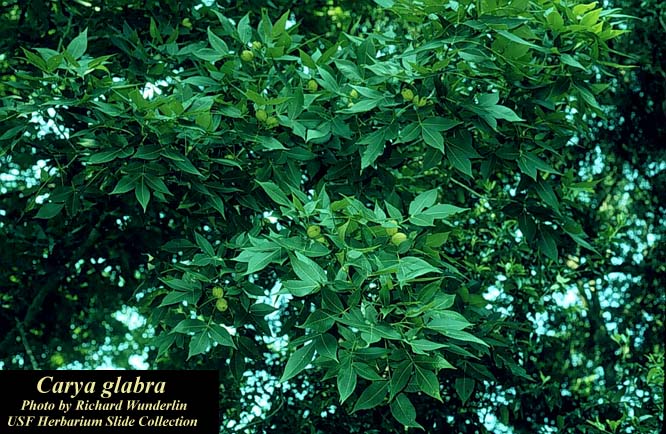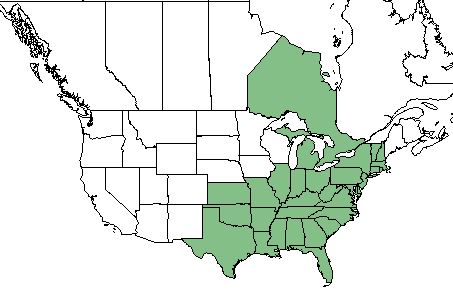Difference between revisions of "Carya glabra"
(→Taxonomic Notes) |
|||
| Line 19: | Line 19: | ||
}} | }} | ||
==Taxonomic Notes== | ==Taxonomic Notes== | ||
| + | Synonyms: ''Carya glabra'' var. ''glabra'', ''Carya glabra'' var. ''megacarpa'' (Sargent) Sargent, ''Carya ovalis'' (Wangenheim) Sargent var. ''hirsuta'' (W.W. Ashe) Sargent, ''Hicoria glabra'' (P. Miller) Britton var. ''glabra'', ''Hicoria glabra'' (P. Miller) Britton var. ''hirsuta'' W.W. Ashe, ''Hicoria austrina'' Small | ||
| + | |||
Subspecies: ''Carya ovalis'' | Subspecies: ''Carya ovalis'' | ||
| − | |||
| − | |||
==Description== | ==Description== | ||
Revision as of 17:28, 26 June 2018
Common name: pignut hickory [1]
| Carya glabra | |
|---|---|

| |
| Photo by the Atlas of Florida Plants Database | |
| Scientific classification | |
| Kingdom: | Plantae |
| Division: | Magnoliophyta - Flowering plants |
| Class: | Magnoliopsida - Dicots |
| Order: | Juglandales |
| Family: | Juglandaceae |
| Genus: | Carya |
| Species: | C. glabra |
| Binomial name | |
| Carya glabra Mill. | |

| |
| Natural range of Carya glabra from USDA NRCS Plants Database. | |
Contents
Taxonomic Notes
Synonyms: Carya glabra var. glabra, Carya glabra var. megacarpa (Sargent) Sargent, Carya ovalis (Wangenheim) Sargent var. hirsuta (W.W. Ashe) Sargent, Hicoria glabra (P. Miller) Britton var. glabra, Hicoria glabra (P. Miller) Britton var. hirsuta W.W. Ashe, Hicoria austrina Small
Subspecies: Carya ovalis
Description
C. glabra is a perennial tree of the Juglandaceae family native to North America and Canada. [1]
Distribution
C. glabra is found in the southeastern corner of the United States, as well as the Ontario region of Canada. [1]
Ecology
Habitat
C. glabra is found in a wide variety of forests and woodlands, but most often non-wetland areas. [2] It has also been found along moist roadsides. [3]
Phenology
C. glabra flowers all months of the year with the exception of January. [4]
Fire ecology
C. glabra is not fire resistant, but has a medium fire tolerance. [1]
Use by animals
C. glabra is not highly palatable to grazing or browsing animals, but is highly palatable to humans. [1]
Conservation and Management
Cultivation and restoration
Photo Gallery
References and notes
- ↑ 1.0 1.1 1.2 1.3 1.4 USDA Plant Database https://plants.usda.gov/core/profile?symbol=CAGL8 Cite error: Invalid
<ref>tag; name "USDA Plant Database" defined multiple times with different content - ↑ Weakley, A. S. (2015). Flora of the Southern and Mid-Atlantic States. Chapel Hill, NC, University of North Carolina Herbarium.
- ↑ URL: http://herbarium.bio.fsu.edu. Last accessed: June 2018. Collectors: L. B. Trott, Donald E. Stone, H. Kurz, L. Baltzell, A. F. Clewell, S. W. Leonard, - Thompson, Robert K. Godfrey, Patricia Elliot, Loran C. Anderson, K. Craddock Burks, D. B. Ward, D. Burch. States and counties: Wakulla County Florida, Escambia County Florida, Liberty County Florida, Marion County Florida, Madison County Florida, Franklin County Florida, Walton County Florida, Santa Rosa County Florida, Leon County Florida, Gadsden County Florida, Hernando County Florida, Taylor County Florida, Okaloosa County Florida, Jefferson County Florida, Suwannee County Florida, Hamilton County Florida, Hardee County Florida, Levy County Florida, Sarasota County Florida, Columbia County Florida
- ↑ PanFlora Author: Gil Nelson URL: http://www.gilnelson.com/PanFlora/ Date Accessed: 5/17/18